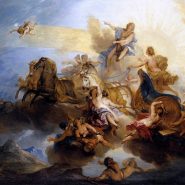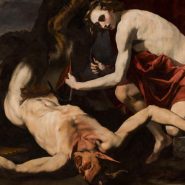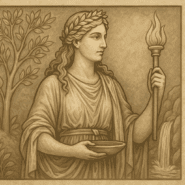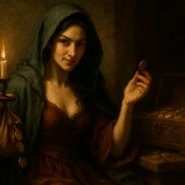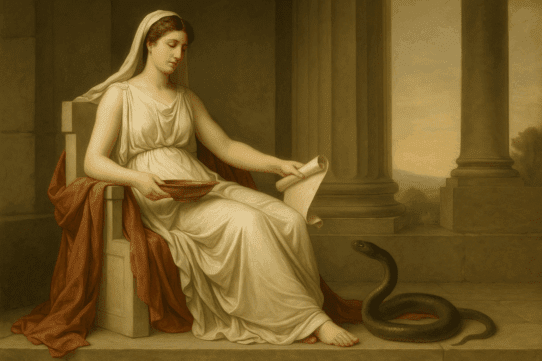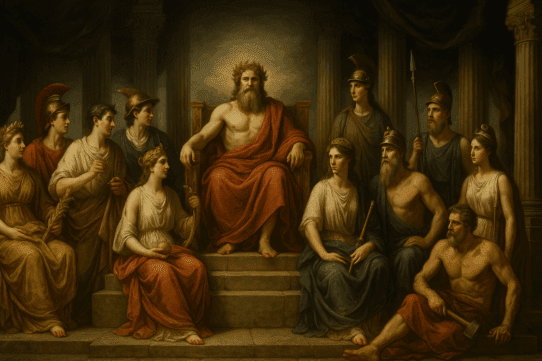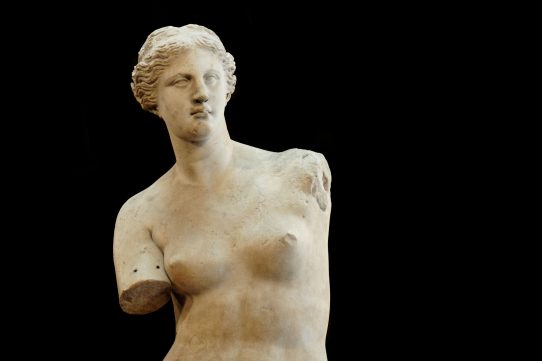Among the many divine figures who shaped ancient Roman religious life, Dea Dia stands as one of the most quietly influential.
She was the goddess of growth, renewal, and the flourishing of the natural world, honored not by the masses but by a highly specialized priestly college whose rituals preserved some of the oldest traditions in Roman memory. Though her name does not often appear alongside more famous goddesses, her presence was essential. Where she presided, life returned, fields revived, and the rhythm of seasons continued unhindered.
To understand Dea Dia is to explore Rome’s agricultural core, a world where the prosperity of the community depended on the renewal of crops and the steady generosity of the earth. Her story is one of tradition, ritual, and the delicate balance between humans and nature.
Origins and Identity of Dea Dia
Dea Dia’s name is simple, yet deeply meaningful. It translates roughly to “the Bright Goddess” or “the Goddess of Daylight,” though ancient writers often understood her as a deity tied more broadly to the renewal of vegetation and the cyclical rebirth of the natural world. She was not a goddess of dramatic myth but one of vital function, woven into the agricultural fabric that sustained Roman life.
Her origins predate many of the more elaborate cults of later Rome. Scholars believe she belonged to an older layer of Italic religion, rooted in the primal connection between human survival and the land. The Romans inherited her worship from these early traditions and preserved it with remarkable care.
A Goddess Served by the Arval Brothers
The most distinctive aspect of Dea Dia’s worship is the priesthood devoted entirely to her: the Fratres Arvales, or the Arval Brothers. This ancient priestly college claimed legendary origins, tying itself to the time of Romulus. According to tradition, the group was founded by Acca Larentia, the foster mother of Romulus and Remus, whose own sons helped establish the fraternity.
By historical times, the Arval Brothers consisted of twelve high-ranking priests who performed highly ceremonial rites to ensure the fertility of fields and the prosperity of Rome. Their rituals were formal, complex, and steeped in antiquity. Every year they held a three-day festival for Dea Dia at a sacred grove outside the city, carefully preserved and passed down through generations.
The liturgy of these priests offers one of the best windows into Rome’s earliest religious practices. Their hymns, including the famous Carmen Arvale, reflect language older than classical Latin and reveal a world in which divine forces were believed to interact directly with the land.
The Annual Festival of Dea Dia
The celebration of Dea Dia’s festival formed one of the most important agricultural rituals in Roman religion. Over several days, the Arval Brothers conducted processions, sacrifices, and prayers in her honor. While the exact details varied over time, the central themes remained clear: blessing the crops, purifying the land, and invoking renewal.
The festival involved:
- A procession through fields and sacred boundaries
- Ritual offerings of grain, wine, incense, and animals
- A ceremonial meal shared by the priests
- Recitation of ancient hymns
- Rites of purification intended to safeguard the city’s harvest
These actions were not symbolic performances but serious obligations meant to secure the well-being of Rome itself. If Dea Dia favored the people, crops would grow strong and plentiful. If she withheld her blessing, famine became a feared possibility.
The rituals took place in a sacred grove, a natural sanctuary that represented the raw power of growth. The grove was not merely a backdrop but a participant in the ceremony, a living space where divine and earthly forces intertwined.
Symbolism and Meaning
Because Dea Dia does not appear in dramatic myth cycles, her character emerges through symbolism rather than narrative.
Goddess of Agricultural Renewal
Her connection to crops, fields, and the restoration of natural vitality placed her at the center of Rome’s agricultural worldview. She represented the moment when dormant land awakens and pushes new life to the surface.
Guardian of Seasonal Cycles
Dea Dia embodied the balance of nature. With each cycle of sowing and harvest, she reinforced the idea that renewal was a sacred and dependable rhythm.
Preserver of Roman Tradition
Her rituals, among the oldest in Roman religion, tied the community to its origins. Through Dea Dia, Rome remembered its rural beginnings and the rituals that sustained earlier generations.
Symbol of Communal Prosperity
To honor Dea Dia was to acknowledge that growth was a shared blessing. Fields did not thrive in isolation. They prospered through cooperation between people, land, and the divine.
The Carmen Arvale and Ancient Ritual Language
One of the most remarkable legacies associated with Dea Dia is the Carmen Arvale, a hymn preserved by the Arval Brothers. It contains fragments of archaic Latin that predate classical literature by centuries. Although the language is difficult to interpret, its tone suggests a plea for protection and vitality.
The hymn reflects a world in which supernatural forces were addressed directly, and where ritual poetry held real power. Through it, we gain insight into how ancient Romans conceived of divine relationships. Dea Dia was not distant. She was invoked with urgency, respect, and the expectation that she would answer.
Dea Dia in the Wider Roman Pantheon
Dea Dia remained a specialized goddess rather than a universal one. Unlike Ceres, who represented agriculture broadly, or Flora, who represented blooming flowers, Dea Dia presided specifically over the processes of growth and renewal. Her role was distinct, focused, and essential.
Her worship never faded into obscurity. Instead, it remained stable, maintained by the Arval Brothers even through the political changes of the empire. Emperors attended her rites, restored her sanctuary, and took pride in continuing traditions that linked Rome to its earliest identity.
In this way, Dea Dia bridges Rome’s pastoral past and its expansive future. She reflects the enduring truth that every city, no matter how powerful, relies on the fragile generosity of nature.
Legacy and Modern Relevance
In the modern imagination, Dea Dia represents renewal in its purest form. Her presence speaks to the longing for cycles of rest, rebirth, and sustainable growth. The ancient belief that prosperity arises from balance between people and land remains relevant as contemporary societies navigate their own relationship with nature.
Her legacy invites us to consider:
- The importance of seasonal rhythms
- The role of nature in shaping human culture
- The value of rituals that honor renewal
- The enduring connection between community and land
Through Dea Dia, we remember that growth is not simply a biological event. It is a sacred pattern that shaped civilizations.
Conclusion
Dea Dia’s quiet influence permeated some of the most ancient and essential rituals of Rome. As the goddess of growth and renewal, she sustained the rhythms that fed the city and upheld the traditions that defined it. Her worship reflects a Rome deeply connected to nature, respectful of its cycles, and aware that renewal was the foundation of survival.
In honoring Dea Dia, the Romans honored life itself. Her story continues to remind us that renewal is a force of both nature and spirit, one that guides communities through every season of change.
